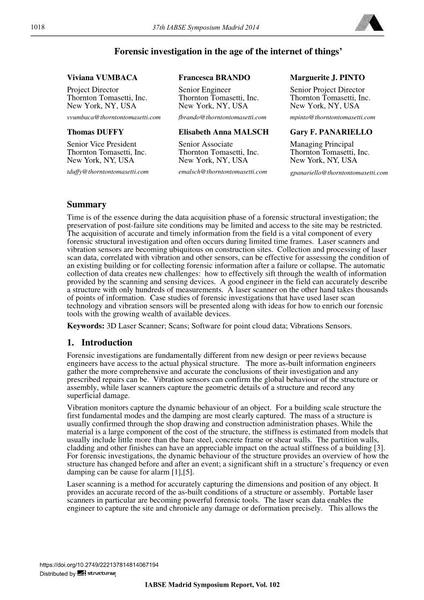Forensic investigation in the age of the internet of things'

|
|
|||||||||||
Détails bibliographiques
| Auteur(s): |
Viviana Vumbaca
Francesca Brando Marguerite J. Pinto Thomas Duffy Elisabeth Anna Malsch Gary F. Panariello |
||||
|---|---|---|---|---|---|
| Médium: | papier de conférence | ||||
| Langue(s): | anglais | ||||
| Conférence: | IABSE Symposium: Engineering for Progress, Nature and People, Madrid, Spain, 3-5 September 2014 | ||||
| Publié dans: | IABSE Symposium Madrid 2014 | ||||
|
|||||
| Page(s): | 1018-1023 | ||||
| Nombre total de pages (du PDF): | 6 | ||||
| Année: | 2014 | ||||
| DOI: | 10.2749/222137814814067194 | ||||
| Abstrait: |
Time is of the essence during the data acquisition phase of a forensic structural investigation; the preservation of post-failure site conditions may be limited and access to the site may be restricted. The acquisition of accurate and timely information from the field is a vital component of every forensic structural investigation and often occurs during limited time frames. Laser scanners and vibration sensors are becoming ubiquitous on construction sites. Collection and processing of laser scan data, correlated with vibration and other sensors, can be effective for assessing the condition of an existing building or for collecting forensic information after a failure or collapse. The automatic collection of data creates new challenges: how to effectively sift through the wealth of information provided by the scanning and sensing devices. A good engineer in the field can accurately describe a structure with only hundreds of measurements. A laser scanner on the other hand takes thousands of points of information. Case studies of forensic investigations that have used laser scan technology and vibration sensors will be presented along with ideas for how to enrich our forensic tools with the growing wealth of available devices. |
||||
